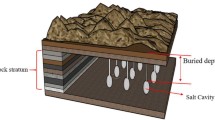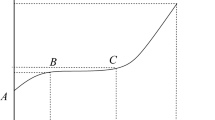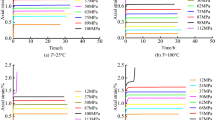Abstract
Time-dependent deformation is critical for ensuring safety and efficiency in horizontal well stability and the long-term permeability of shale gas. Purely empirical methods that lack a physical background cannot reflect the mechanism of shale creep, and classical elemental models lack control over both viscous and elastic parameters, leading to poor nonlinear behavior. Moreover, an appropriate amount of time is necessary to perform time-dependent deformation testing as such testing usually takes a long time. Additionally, reports on radial creep data for shale are rare. In this study, several short-term and long-term deformation experiments were conducted on shale samples to evaluate their deformation behavior. Furthermore, a modified creep constitutive model was proposed to fit the measured data; the result was a perfect fitting. The experimental results showed that axial deformations have significant anisotropy and differential stress dependence, whereas radial deformations do not. Volumetric deformations can form three types of strain–time profiles. Creep compliance (3 h) was negatively correlated with Young’s modulus and Poisson’s ratio. Model validation showed that the shale creep deformation would be incorrectly estimated without the new model, which outperformed the classical model in the deceleration stage. Model parameters α and β, which reflect the degree of viscoelasticity in the shale, were negatively correlated with Young’s modulus and the differential stress. In addition, using the new model to predict the behavior of creep deformation through short-term (48 h) creep experiments is feasible.


















Similar content being viewed by others
Data Availability
The authors declare that they have no known competing financial interests or personal relationships that could have appeared to influence the work reported in this paper. Data will be made available on request from the corresponding author.
References
Asala HI, Ahmadi M, Dahi Taleghani A (2016) Why re-fracturing works and under what conditions. Proc - SPE Annu Tech Conf Exhib. https://doi.org/10.2118/181516-ms
Bažant ZP, Jirásek M (2018) Creep and hygrothermal effects in concrete structures. Springer Dordrecht, Berlin and Heidelberg. https://doi.org/10.1007/978-94-024-1138-6
Chang C, Zoback MD (2008) Creep in unconsolidated shale and its implication on rock physical properties. In: The 42nd U.S. rock mechanics symposium (USRMS), San Francisco, California, June 2008 ARMA-08-130
Chang C, Zoback MD (2009) Viscous creep in room-dried unconsolidated Gulf of Mexico shale (I): Experimental results. J Pet Sci Eng 69:239–246. https://doi.org/10.1016/j.petrol.2009.08.018
Chen T, Feng XT, Pan Z (2015) Experimental study of swelling of organic rich shale in methane. Int J Coal Geol 150–151:64–73. https://doi.org/10.1016/j.coal.2015.08.001
Chen T, Feng XT, Pan Z (2018) Experimental study on kinetic swelling of organic-rich shale in CO2, CH4 and N2. J Nat Gas Sci Eng 55:406–417. https://doi.org/10.1016/j.jngse.2018.04.027
Chen T, Feng XT, Cui G et al (2019) Experimental study of permeability change of organic-rich gas shales under high effective stress. J Nat Gas Sci Eng 64:1–14. https://doi.org/10.1016/j.jngse.2019.01.014
Chen T, Zheng X, Qiu X et al (2021) Experimental study on the feasibility of microwave heating fracturing for enhanced shale gas recovery. J Nat Gas Sci Eng 94:104073. https://doi.org/10.1016/j.jngse.2021.104073
Cheng W, Cui G, Tan Y, Elsworth D, Wang C, Yang C, Chen T, Jiang C (2024) A multi-layer nanocased model to explain the U-shaped evolution of shale gas permeability at constant confining pressure. Fuel 359:130478. https://doi.org/10.1016/j.fuel.2023.130478
Cui G, Liu J et al (2018) Why shale permeability changes under variable effective stresses: new insights. Fuel 213:55–71. https://doi.org/10.1016/j.fuel.2017.10.068
Cui G, Wei J, Feng XT et al (2019) Preliminary study on the feasibility of co-exploitation of coal and uranium. Int J Rock Mech Min Sci 123:104098. https://doi.org/10.1016/j.ijrmms.2019.104098
Cui G, Tan Y et al (2020a) Multidomain two-phase flow model to study the impacts of hydraulic fracturing on shale gas production. Energy Fuels 34(4):4273–4288. https://doi.org/10.1021/acs.energyfuels.0c00062
Cui G, Tan Y, Chen T et al (2020c) Multidomain two-phase flow model to study the impacts of hydraulic fracturing on shale gas production. Energy Fuels 34:4273–4288. https://doi.org/10.1021/acs.energyfuels.0c00062
Cui G, Xia-Ting F, Pan Z et al (2020d) Impact of shale matrix mechanical interactions on gas transport during production. J Pet Sci Eng 184:106524. https://doi.org/10.1016/j.petrol.2019.106524
Cui G, Xia-Ting F, Pan Z, Chen T, Liu J, Elsworth D, Tan Y, Wang C (2020) Impact of shale matrix mechanical interactions on gas transport during production. J Pet Sci Eng 184:106524. https://doi.org/10.1016/j.petrol.2019.106524
Deng H, Zhou H, Wei Q, Li L, Jia W (2023) A creep constitutive model based on Atangana–Baleanu fractional derivative. Mech Time-Depend Mater 27:1171–1186. https://doi.org/10.1007/s11043-022-09560-1
Di Paola M, Pirrotta A, Valenza A (2011) Visco-elastic behavior through fractional calculus: an easier method for best fitting experimental results. Mech Mater 43:799–806. https://doi.org/10.1016/j.mechmat.2011.08.016
Di Paola M, Failla G, Pirrotta A (2012) Stationary and non-stationary stochastic response of linear fractional viscoelastic systems. Probabilistic Eng Mech 28:85–90. https://doi.org/10.1016/j.probengmech.2011.08.017
Eberhart R, Kennedy J (1955) A new optimizer using particle swarm theory. MHS'95. In: Proceedings of the sixth international symposium on micro machine and human science, Nagoya, pp 39–43. https://doi.org/10.1109/MHS.1995.494215
Eberhart RC, Shi Y (2001) Particle swarm optimization: developments, applications and resources. Proc IEEE Conf Evol Comput ICEC 1:81–86. https://doi.org/10.1109/cec.2001.934374
Geng Z, Bonnelye A, Chen M et al (2017) Elastic anisotropy reversal during brittle creep in shale. Geophys Res Lett 44:10,887-10,895. https://doi.org/10.1002/2017GL074555
Geng Z, Bonnelye A, Chen M et al (2018) Time and temperature dependent creep in Tournemire Shale. J Geophys Res Solid Earth 123:9658–9675. https://doi.org/10.1029/2018JB016169
Haghighat E, Rassouli FS, Zoback MD, Juanes R (2020) A viscoplastic model of creep in shale. Geophysics 85:MR155–MR166. https://doi.org/10.1190/geo2018-0700.1
Huang P, Zhang J, Jean Damascene N et al (2021) A fractional order viscoelastic-plastic creep model for coal sample considering initial damage accumulation. Alexandria Eng J 60:3921–3930. https://doi.org/10.1016/j.aej.2021.02.054
Jaishankar A, McKinley GH (2013) Power-law rheology in the bulk and at the interface: quasi-properties and fractional constitutive equations. Proc R Soc A: Math Phys Eng Sci 469:1471–2946. https://doi.org/10.1098/rspa.2012.0284
Kai-Xin H, Ke-Qin Z (2009) Mechanical analogies of fractional elements. Chin Phys Lett 26:10. https://doi.org/10.1088/0256-307X/26/10/108301
Kamali-Asl A, Ghazanfari E (2017) Investigating the creep response of Marcellus Shale Formations. Geotechnical Frontiers 2017(2017):562–569. https://doi.org/10.1061/9780784480472.059
Kang J, Zhou F, Liu C, Liu Y (2015) A fractional non-linear creep model for coal considering damage effect and experimental validation. Int J Non Linear Mech 76:20–28. https://doi.org/10.1016/j.ijnonlinmec.2015.05.004
Kilbas AA, Marichev OI, Samko SG (1993) Fractional integrals and derivatives (theory and applications). Gordon and Breach, Switzerland
Lacy LL, Rickards AR, Bilden DM (1998) Fracture width and embedment testing in soft reservoir sandstone. SPE Drill Complet 13:25–29. https://doi.org/10.2118/36421-PA
Lakes R, Lakes RS (2009) Viscoelastic materials. Cambridge University Press
Lewandowski R, Chorazyczewski B (2010) Identification of the parameters of the Kelvin-Voigt and the Maxwell fractional models, used to modeling of viscoelastic dampers. Comput Struct 88:1–17. https://doi.org/10.1016/j.compstruc.2009.09.001
Li C, Bažant ZP, Xie H, Rahimi-Aghdam S (2019) Anisotropic microplane constitutive model for coupling creep and damage in layered geomaterials such as gas or oil shale. Int J Rock Mech Min Sci 124:104074. https://doi.org/10.1016/j.ijrmms.2019.104074
Liang Z, Chen Z, Rahman SS (2020) Experimental investigation of the primary and secondary creep behaviour of shale gas reservoir rocks from deep sections of the Cooper Basin. J Nat Gas Sci Eng 73:103044. https://doi.org/10.1016/j.jngse.2019.103044
Liao M, Lai Y, Liu E, Wan X (2017) A fractional order creep constitutive model of warm frozen silt. Acta Geotech 12:377–389. https://doi.org/10.1007/s11440-016-0466-4
Lockner D (1993) Room temperature creep in saturated granite. J Geophys Res 98:475–487. https://doi.org/10.1029/92JB01828
Lu S, Wang C, Li M et al (2021) Gas time-dependent diffusion in pores of deformed coal particles: model development and analysis. Fuel 295:120566. https://doi.org/10.1016/j.fuel.2021.120566
Lu S, Li M, Ma Y et al (2022a) Permeability changes in mining-damaged coal: A review of mathematical models. J Nat Gas Sci Eng 106:104739. https://doi.org/10.1016/j.jngse.2022.104739
Lu S, Li M, Sa Z et al (2022b) Discrimination of gas diffusion state in intact coal and tectonic coal: Model and experiment. Fuel 325:124916. https://doi.org/10.1016/j.fuel.2022.124916
Mainardi F, Spada G (2011) Creep, relaxation and viscosity properties for basic fractional models in rheology. Eur Phys J Spec Top 193:133–160. https://doi.org/10.1140/epjst/e2011-01387-1
Ortigueira MD (2011) Fractional calculus for scientists and engineers. Springer Dordrecht, Berlin and Heidelberg. https://doi.org/10.1007/978-94-007-0747-4
Peng Y, Zhao J, Li Y (2017) A wellbore creep model based on the fractional viscoelastic constitutive equation. Pet Explor Dev 44:1038–1044. https://doi.org/10.1016/S1876-3804(17)30117-9
Peng Y, Zhao J, Sepehrnoori K, Li Z (2020) Fractional model for simulating the viscoelastic behavior of artificial fracture in shale gas. Eng Fract Mech 228:106892. https://doi.org/10.1016/j.engfracmech.2020.106892
Poli R, Kennedy J, Blackwell T (2007) Particle swarm optimization an overview. Swarm Intell 1:33–57. https://doi.org/10.1007/s11721-007-0002-0
Rassouli FS, Zoback MD (2016) A comparison of short-term and long-term creep experiments in unconventional reservoir formations. In: 50th U.S. rock mechanics/geomechanics symposium, Houston, Texas, June 2016 ARMA-2016-430
Rassouli FS, Zoback MD (2018) Comparison of short-term and long-term creep experiments in shales and carbonates from unconventional gas reservoirs. Rock Mech Rock Eng 51:1995–2014. https://doi.org/10.1007/s00603-018-1444-y
Rybacki E, Reinicke A, Meier T et al (2015) What controls the mechanical properties of shale rocks? - Part I: Strength and Young’s modulus. J Pet Sci Eng 135:702–722. https://doi.org/10.1016/j.petrol.2015.10.028
Sar EYA, Giresunlu IB (2016) Fractional differential equations. Pramana-J Phys 87:17
Sasso M, Palmieri G, Amodio D (2011) Application of fractional derivative models in linear viscoelastic problems. Mech Time-Dependent Mater 15:367–387. https://doi.org/10.1007/s11043-011-9153-x
Schmidt A, Gaul L (2002) Finite element formulation of viscoelastic constitutive equations using fractional time derivatives. Nonlinear Dyn 29:37–55. https://doi.org/10.1023/A:1016552503411
Schoenball M, Sahara DP, Kohl T (2014) Time-dependent brittle creep as a mechanism for time-delayed wellbore failure. Int J Rock Mech Min Sci 70:400–406. https://doi.org/10.1016/j.ijrmms.2014.05.012
Scott Blair GW (1947) The role of psychophysics in rheology. J Colloid Sci 2:21–32. https://doi.org/10.1016/0095-8522(47)90007-X
Shi X, Yang X, Yue W et al (2022) Experimental investigation on the creep behaviors of shale using nanoindentation technique and fractional constitutive models. J Pet Sci Eng 215:110520. https://doi.org/10.1016/j.petrol.2022.110520
Sizova E, Gerya T, Stüwe K, Brown M (2015) Generation of felsic crust in the Archean: A geodynamic modeling perspective. Precambrian Res 271:198–224. https://doi.org/10.1016/j.precamres.2015.10.005
Sone H (2012) Mechanical properties of shale gas reservoir rocks, and its relation to the in-situ stress variation observed in shale gas reservoirs. PhD dissertation, Stanford University
Sone H, Zoback MD (2013) Mechanical properties of shale-gas reservoir rocks - part 2: Ductile creep, brittle strength, and their relation to the elastic modulus. Geophysics 78:. https://doi.org/10.1190/GEO2013-0051.1
Sone H, Zoback MD (2014) Time-dependent deformation of shale gas reservoir rocks and its long-term effect on the in situ state of stress. Int J Rock Mech Min Sci 69:120–132. https://doi.org/10.1016/j.ijrmms.2014.04.002
Song Y, Wang H, Chang Y, Li Y (2019) Nonlinear creep model and parameter identification of mudstone based on a modified fractional viscous body. Environ Earth Sci 78:1–12. https://doi.org/10.1007/s12665-019-8619-z
Spain DR, Anderson GA (2010) Controls on reservoir quality and productivity in the Haynesville Shale, Northwestern Gulf of Mexico Basin. Gulf Coast Assoc Geol Soc Trans 60:657–668
Sun Z, Chen T, Zhu L et al (2022) Analysis of the upper and lower boundaries of permeability evolution during shale rock shear deformation. Energy Fuels 36:2007–2022. https://doi.org/10.1021/acs.energyfuels.1c03873
Sun Z, Elsworth D, Cui G, Li Y, Zhu A, Chen T (2024) Impacts of rate of change in effective stress and inertial effects on fault slip behavior: new insights into injection‐induced earthquakes[J]. J Geophys Res: Solid Earth 129(2):e2023JB027126
Townend J, Zoback MD (2001) Implications of earthquake focal mechanisms for the frictional strength of the San Andreas fault system. Geol Soc Spec Publ 186:13–21. https://doi.org/10.1144/GSL.SP.2001.186.01.02
Trzeciak M, Sone H, Dabrowski M (2018) Long-term creep tests and viscoelastic constitutive modeling of lower Paleozoic shales from the Baltic Basin, N Poland. Int J Rock Mech Min Sci 112:139–157. https://doi.org/10.1016/j.ijrmms.2018.10.013
Van Den Bergh F, Engelbrecht AP (2006) A study of particle swarm optimization particle trajectories. Inf Sci (Ny) 176:937–971. https://doi.org/10.1016/j.ins.2005.02.003
van Oort E (2003) On the physical and chemical stability of shales. J Pet Sci Eng 38:213–235. https://doi.org/10.1016/S0920-4105(03)00034-2
Villamor Lora R, Ghazanfari E (2015) Creep behavior of shale formations in shale gas development. IFCEE 2015:2024–2033
Welch SWJ, Rorrer RAL, Duren RG (1999) Application of time-based fractional calculus methods to viscoelastic creep and stress relaxation of materials. Mech Time-Dependent Mater 3:279–303. https://doi.org/10.1023/A:1009834317545
Xu H, Jiang X (2017) Creep constitutive models for viscoelastic materials based on fractional derivatives. Comput Math with Appl 73:1377–1384. https://doi.org/10.1016/j.camwa.2016.05.002
Yan B, Guo Q, Ren F, Cai M (2020) Modified Nishihara model and experimental verification of deep rock mass under the water-rock interaction. Int J Rock Mech Min Sci 128:104250. https://doi.org/10.1016/j.ijrmms.2020.104250
Zhang JZ, Zhou XP, Yin P (2019) Visco-plastic deformation analysis of rock tunnels based on fractional derivatives. Tunn Undergr Sp Technol 85:209–219. https://doi.org/10.1016/j.tust.2018.12.019
Zhou HW, Wang CP, Han BB, Duan ZQ (2011) A creep constitutive model for salt rock based on fractional derivatives. Int J Rock Mech Min Sci 48:116–121. https://doi.org/10.1016/j.ijrmms.2010.11.004
Zhou HW, Wang CP, Mishnaevsky L et al (2013) A fractional derivative approach to full creep regions in salt rock. Mech Time-Dependent Mater 17:413–425. https://doi.org/10.1007/s11043-012-9193-x
Zhou C, Yin K, Cao Y, Ahmed B (2016) Application of time series analysis and PSO-SVM model in predicting the Bazimen landslide in the Three Gorges Reservoir, China. Eng Geol 204:108–120. https://doi.org/10.1016/j.enggeo.2016.02.009
Zhou HW, Zhang L, Wang XY et al (2020) Effects of matrix-fracture interaction and creep deformation on permeability evolution of deep coal. Int J Rock Mech Min Sci 127:104236. https://doi.org/10.1016/j.ijrmms.2020.104236
Zhou J, Zhang J, Wang J et al (2022) Research on nonlinear damage hardening creep model of soft surrounding rock under the stress of deep coal resources mining. Energy Rep 8:1493–1507. https://doi.org/10.1016/j.egyr.2022.02.093
Zoback M, Kohli A (2019) Unconventional reservoir geomechanics: shale gas, tight oil, and induced seismicity. Cambridge University Press
Acknowledgements
The research delivered partial results with the support of the National Key R&D Program of China (2021YFC2902101). Open Foundation of National Energy shale gas R&D (experiment) centre (2022-KFKT-12). National Natural Science Foundation of China (12002081), and the 111 Project (B17009).
Author information
Authors and Affiliations
Corresponding author
Ethics declarations
Competing interests
The authors declare no competing interests.
Appendices
Appendix A
Please see Figs. 19, 20 and 21.
Appendix B
Please see Fig. 22.
The nonlinear creep model of shale is composed of three parts: the Hooke body; fractional element; and fractional Kelvin-Voigt model. According to the series rule, their relationship with the total stress \(\sigma\) and strain \(\varepsilon\) can be expressed as follows:
The subscript are connected in series, assuming that the strain of the Hooke body is εe and the stress is σe, the strain of the fractional element is εvi and the stress is σvi, and the strain of the fractional Kelvin-Voigt model is εve and the stress is σve.
-
(i)
The stress–strain relationship of the Hooke body is:
$${\varepsilon }_{e}=\frac{{\sigma }_{e}}{{E}_{1}}=\frac{\sigma }{{E}_{1}}$$(13) -
(ii)
The stress–strain relationship of the fractional element is:
Displayed in the “Fractional element with variable viscosity coefficients” section the viscosity coefficient is a function of time obeying the relation η(t) = η10·e−ωt. Bringing in the constitutive relation of the fractional element, we obtain Eq. (14).
$$\begin{array}{cc}\sigma \left(t\right)={\eta }_{10}\cdot {e}^{-\omega t}\cdot \frac{{d}^{\alpha }\varepsilon \left(t\right)}{{dt}^{\alpha }}& \left(0\le \alpha \le 1\right)\end{array}$$(14)Substitute the constant σ(t) = σvi, σvi (the creep stress) into Eq. (14), and we apply the Laplace transform for Eq. (14) to obtain:
$$\varepsilon \left(s\right)=\frac{{\sigma }_{vi}}{{\eta }_{10}\left(s-\omega \right){s}^{\alpha }}$$(15)In the solution process we must apply the Laplace inverse transform of the two-parameter Mittag–Leffler function, which are defined respectively as57, 74:
$$\begin{array}{cc}{\int }_{0}^{\infty }{e}^{-st}{t}^{zk+b-1}{E}_{a,b}^{\left(k\right)}\left(\pm {pt}^{a}\right)dt=\frac{k!{s}^{a-b}}{{\left({s}^{a}\mp p\right)}^{k+1}}& \left({\text{Re}}\left(s\right)>{\left|p\right|}^{1/a}\right)\end{array}$$(16)where a, b, and k are the Mittag–Leffler function parameters. Finally, the creep equation for the fractional-order element with variable viscosity coefficient is obtained as:
$$\begin{array}{cc}\varepsilon \left(t\right)=\frac{{\sigma }_{vi}}{{\eta }_{10}}\cdot {t}^{\alpha }{E}_{1,\alpha +1}\left(\omega t\right)& \left(0<\alpha <1\right)\end{array}$$(17) -
(iii)
According to the parallel theory of the combined model, the stress–strain relationship of the fractional Kelvin-Voigt model can be obtained as follows:
$$\left\{\begin{array}{c}{\varepsilon }_{ve}={\varepsilon }_{H}={\varepsilon }_{F}\\ {\sigma }_{ve}={\sigma }_{H}+{\sigma }_{F}\end{array}\right.$$(18)where εH and σH are the strains and stresses of the spring, and εF and σF are the strains and stresses of the fractional-order element in part (III). And they obey the following stress–strain relationship: σH = εH·E2 and σF = η20·e−ω·(dβ εF)/dtβ. Substituting into Eq. (18), we obtain the third part of the constitutive equation.
$${\sigma }_{ve}={E}_{2}{\varepsilon }_{ve}+{\eta }_{20}{e}^{-\omega }\cdot \frac{{d}^{\beta }{\varepsilon }_{ve}}{{dt}^{\beta }}$$(19)
Here we assume that σve is a constant, and use the Laplace transform for Eq. (19) to obtain:
Applying the Laplace inverse transform of the two-parameter Mittag–Leffler function (Eq. (17), the creep equation for part (III) can be obtained as:
Finally, the nonlinear fractional shale creep model is obtained by incorporating Eq. (13), Eq. (17) and Eq. (21) into Eq. (12):
Appendix C
Rights and permissions
About this article
Cite this article
Wang, W., Chen, T., Cui, G. et al. New approach for predicting time-dependent deformation of shale rock: a modified fractional-order creep constitutive model. Bull Eng Geol Environ 83, 209 (2024). https://doi.org/10.1007/s10064-024-03626-9
Received:
Accepted:
Published:
DOI: https://doi.org/10.1007/s10064-024-03626-9








